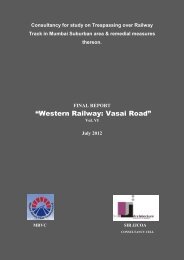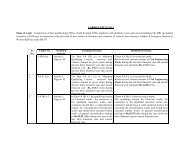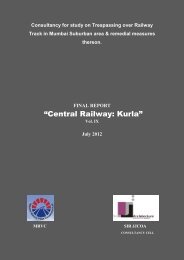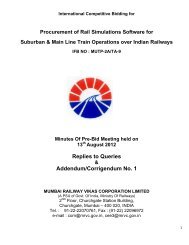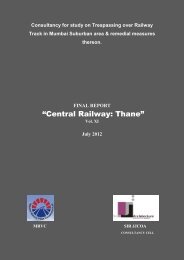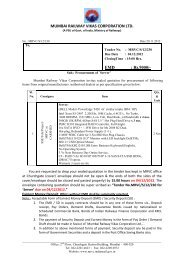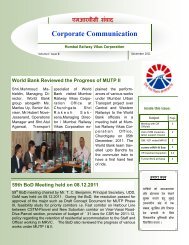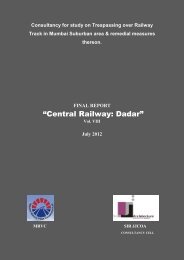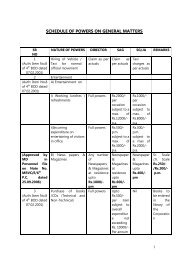World Bank Document - Mumbai Railway Vikas Corporation Ltd ...
World Bank Document - Mumbai Railway Vikas Corporation Ltd ...
World Bank Document - Mumbai Railway Vikas Corporation Ltd ...
You also want an ePaper? Increase the reach of your titles
YUMPU automatically turns print PDFs into web optimized ePapers that Google loves.
Indian <strong>Railway</strong>s’ Development Strategy<br />
90. Indian <strong>Railway</strong>s, with 63,221 route-km of network and 1.42 million employees, is one of<br />
the largest rail networks of the world. It constitutes the lifeline and the mainstay of the country’s<br />
transport infrastructure. Over the last few years, IR has achieved a dramatic re-invention of its<br />
business and is presently witnessing one of the most impressive and unprecedented expansions in<br />
its history. During the last few years the freight traffic on IR has been growing at 9.4 percent and<br />
passenger traffic at 7.4 percent, and revenue has grown even faster. This is in sharp contrast to<br />
the historical trend rates of growth at 3-4 percent per year. In the passenger segment, while<br />
affordability continues to underpin the pricing for second-class passengers, there has been<br />
reduction in fares for passengers in air-conditioned class and those traveling short distance.<br />
These measures have redefined the transport scene in the country and transformed the railways<br />
as a competitive and viable alternative to road transport. By 2012, IR is projected to handle 25<br />
percent more passengers than handled in 2008.<br />
91. During the past five years, IR has achieved commendable results by substantially<br />
increasing the volume of traffic carried and its profits. However, it now faces several new<br />
challenges. The recent increase in the wage bill, accompanied by a downturn in economic growth<br />
in 2009, have already affected IR’s bottom line adversely. In addition, the planned large<br />
investment in Dedicated Freight Corridors (DFC) in the medium term will create excess capacity<br />
in its start-up years that will reduce IR’s profits unless it develops marketing strategies to rapidly<br />
attract new traffic to the existing corridors (mainly passengers), as well as to the new dedicated<br />
freight corridors.<br />
92. Going forward, the expected continued economic growth of India over the next 20 years<br />
at eight percent or more will impose new challenges on IR in respect of capacity, transportation<br />
and logistic products and service quality to be expected by rail customers in freight as well as<br />
passenger services. It is foreseen that the customer’s profile will undergo a significant change, as<br />
an average rail customer is expected to experience a four-to-five fold increase in income and at<br />
the same time will demand more comfortable and faster travel. Customers will be willing to pay<br />
higher fares for these improved services. These challenges can be addressed effectively by<br />
implementing Vision 2020 for IR. An immediate next step would be to develop a credible<br />
financing plan to effectively underpin IR’s developmental plans.<br />
93. Another important step is to develop an action plan (road map) that lays out specific<br />
strategies and measures to be implemented to overcome the present constraints and, more<br />
importantly, to enable IR to satisfactorily support the growing economy by increasing capacity<br />
and improving service quality. IR needs to prioritize actions and investments over the next ten<br />
years and set out an implementation schedule. It will also attempt to identify funding sources for<br />
the recommended investments.<br />
Management of MMR<br />
94. Responsibilities for the general direction of urban development and urban transport rest<br />
with the State Government of Maharashtra (GOM) through the <strong>Mumbai</strong> Metropolitan Region<br />
Development Authority (MMRDA), a regional developmental agency under the Department of<br />
Urban Development. To enable the <strong>Mumbai</strong> Suburban <strong>Railway</strong> to meet the demands of the ever-<br />
26





